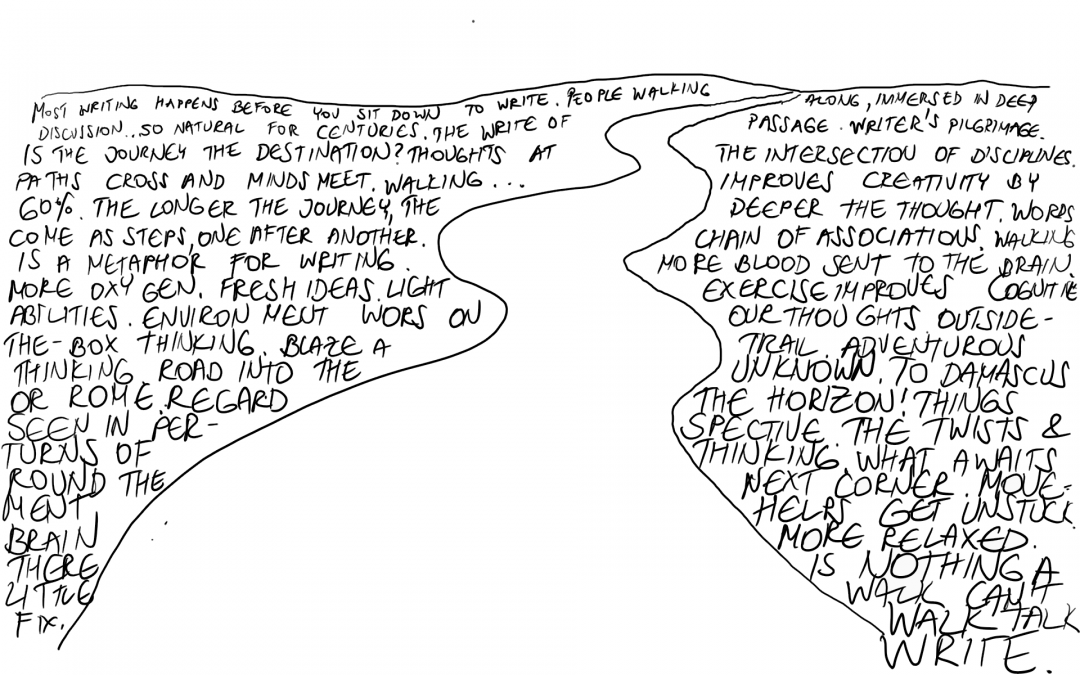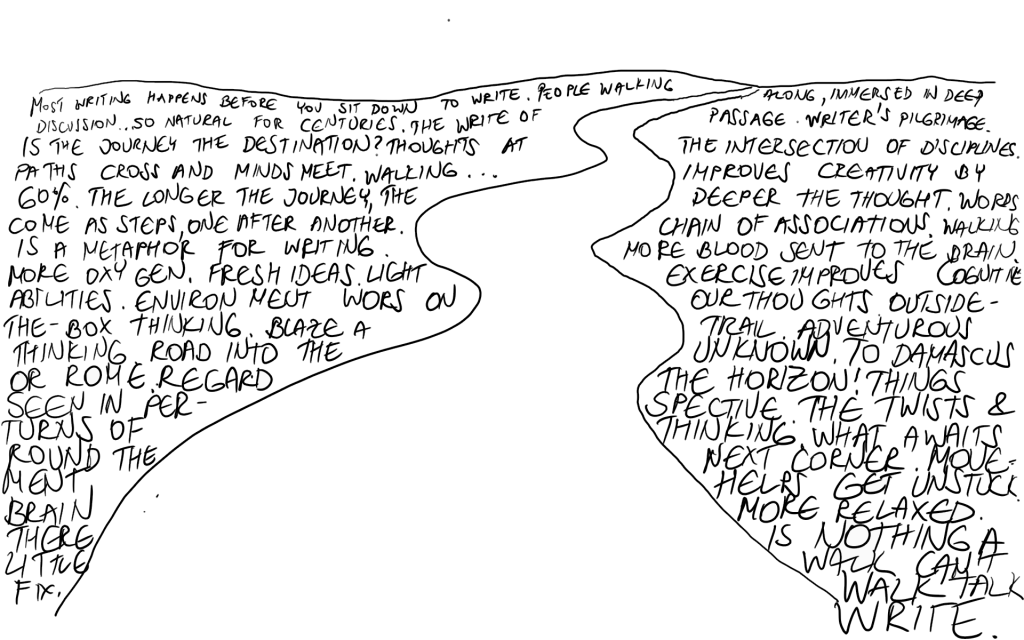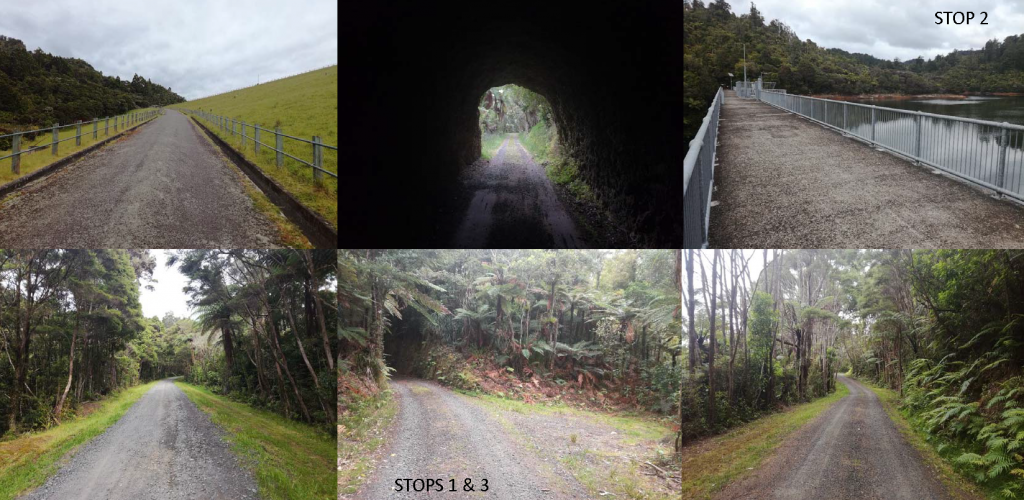* Feel free to borrow from our arrangements and experience to stage your own Walking, Talking, Writing event. We would be grateful if you made a reference to this site and passed on the link to it.
Part I – Motivation
A desire to organize an event for researchers that brings together the three activities came from a very personal need of one of the facilitators to escape to a place where she could think (which is where writing most often starts). There are a few places that, for her, can spin thinking about research into action: a (noisy) café, a (quiet) road.
In the first setting, thinking emerges from inner stillness, from planting oneself quietly in a corner of a café, and watching either the crowds or clouds go by, from observing the world around, while letting oneself (and one’s worries) quietly dissolve within it. At some point, the wandering mind will hook onto a passing thought, and take it into a perhaps unexpected direction. Alternatively, the surrounding buzz of the café could be used as white-noise background so that, in its effort to block out the commotion, the mind builds an enclosure around a single theme, and begins to dwell on it.[1]
In the second case, thinking is generated by the motion of the thinker – the world around peacefully rests, while the thinker, perpetually enticed by the horizon, keeps moving forward along the giant gravel-and-grass treadmill, arranging her steps, and thoughts, one by one. This, too, enables one to lose oneself so that the focus is no longer on the self but well beyond and above it.
Either way, something – one thing – needs to stop, or at least slow down a bit. As we discovered at a writing retreat a year ago, best thinking for many of us happens in moments that combine tension and ease, constraint and freedom, focus and play, rhythm and quiet.
None of this is any news, really, thanks to the many writers who have explored in their books and life the correlation between the movement of the body and that of the mind (think Henry David Thoreau, James Joyce, Virginia Woolf, James Joyce, Paul Auster, William Wordsworth, Walt Whitman, Haruki Murakami, and so on). To borrow the lines from Ferris Jarb’s excellent piece on walking and thinking published in The New Yorker,
“How vain it is to sit down to write when you have not stood up to live!” Henry David Thoreau penned in his journal. “Methinks that the moment my legs begin to move, my thoughts begin to flow.”
It is particularly relevant to present-day research writers who are trapped in their offices and who spend most of their days, pinned to their desks and glued to their computer screens. In other words, to most academics. Our minds as well as bodies are probably quietly (yet desperately) begging for moments of freedom afforded by some movement through open space. That is why an idea to organize a “writerly” walk through the countryside, undisturbed by perpetually arriving emails, door-knocks and meetings, became increasingly appealing to us, to a point when, we felt, it held no less than a promise of a true literary or research pilgrimage. And Spring came along as further enticement.
In the spirit of comradeship and collegiality, we decided to make this journey a shared experience, so that, instead of a solitary walk, the event would bring together a group of research writers from various disciplines and of various ranks.
We would send a bunch of academics on a pre-organized rural one-day walk, during which, while engaged in a physical exercise (walking), they could discuss with one another their writing projects and main challenges related to those. At designated and pre-arranged stopover points, participants would have a chance to rest and write down the best ideas they have taken from those conversations or simply work on their own writing/ideas.
We agreed that the road would serve as a great metaphor for the journey of shared writing. The goal and destination of the event would be the journey itself. Rather than expecting any particular writing outputs, we were more interested in changing one’s thoughts about the writing process itself. We wanted to bring the element of pleasure back into the writing process which, let’s admit once and for all, involves a large amount of thinking about it. We also wanted to help any writers who felt stuck or lost, or who did not know who to start.
In retrospect, going on a Walking, Talking, Writing event seems to us now a most natural solution to writing blockages.
Part II – Preparation
We piloted the first event on a beautiful early summer day (30 November 2017), together with a staff member from Auckland University’s School of Environment, Joe Fagan, who, we knew, was interested in innovative teaching ideas[2]and had the experience to serve as a great field guide for the group, having once been employed in adventure tourism.
The weeks leading up to the event, we agreed on the initial plan:
The walking route
- Should be around 10km long to ensure it is comfortable and affordable time-wise;
- Ideally, a country road (dirt or gravel) with pastoral landscapes, beach views, etc.;
- Could involve some mild ascending/descending (leading, metaphorically, towards a higher level of awareness);
- Should avoid technically demanding routes that involve narrow pathways and/or obstacles, which could divert attention from “walking and talking”;
- Should be comfortable enough for two, or three, people to walk side by side (As we discovered after the walk, the journey works best if people walk into pairs.);
- The road should be safe for walking (ideally, no motorised traffic);
- Should have naturally formed rest areas suitable for intended “writing stops” at logical points throughout;
- Though New Zealand nature spoils its visitors with splendid views, the route could be even somewhat “boring”, as the main idea and the destination in this case should be the journey itself;
- Should be no more than around one hour’s drive away from the City Campus in Auckland where we are based;
- Should have toilets at the start/finish and half-way points.
In the end, we came up with the following route and plan.
And here are the draft itinerary and expenses for our trip, which may be helpful in case you wanted to stage a similar event.
The talking people
- Should be a versatile cohort of researchers at various stages in their careers and from various disciplines;
- Should be a relatively small group for a start (no more than 15).
This is how we advertised the event:
The short, but possibly infinite, journey through the pastoral landscapes along with fellow travellers will involve writerly comradeships and shared burdens, writes of passage, crossing of paths and meeting of minds, fresh ideas, and twists and turns in thinking, parallels between walking and writing, things seen in perspective, idea adventures and roads leading into the unknown, elevated cognitive abilities, and creativity improved by 60%*.
* According to Stanford University
Click here to see the promotional flyer with more detail.
The writing prompts
To encourage the participants to think about the road and journey as metaphors for writing process, ahead of the event we prepared a stack of material relating to roads and on-foot journeys of all kinds: crossroads and intersections, dead-ends and dangerous pathways, desert roads and forest tracks, etc. We used these for small activities while we were being driven to the start of the track. We also asked the group to think of metaphors relating to the topic (“the journey is the destination”, we found, was a popular one).[3]
Part III – The Journey
It’s incredible what travel on foot does to human interaction. Instruct a group of academics to wear comfortable clothes, put them in a small 12-seater van and take them someplace secret for a small rural adventure. Academic ranks and personas (our cohort included senior lecturers, library research staff and PhD candidates, among others) magically disappear and, instead, you have a group of interested and interesting travel companions with lots of stories to share.
The setting and conditions of the walk, therefore, are important for creating the right atmosphere. Let us all share a small amount of dust on our feet, sweat on our foreheads, thirst in our mouths and ache in our leg muscles. Roads bring people and their ideas together – and any (writerly) burden shared with a fellow traveller becomes easier to carry. There are few things that more truthfully and beautifully embody a companionship than two or more people walking side by side along a road, talking.
The ease with which our group split into pairs or threes as we started our walk, and with which they later re-grouped, confirmed that open spaces, a road that must be taken by all, a common goal, a journey into the unknown, some light rain, the beauty of nature, and other elements worked to create a special bond among everyone and a perfect setting for conversation.
For most of the time, we were all so immersed in walking and talking that the first stop – around 3km and 30 minutes from the start – seemed to have come almost too early. On a hot day like that, it was pleasant to sit down in the grassy shade though. We instructed people to write what they felt needed to be written down, and, moments later, silence fell over our heads, disrupted only by occasional bird song and bothered by the buzzing of forest flies. The air felt thick and heavy from concentration. The 20 minutes we had allowed for the pause passed too quickly, and it was painful to ask people to stop their writing, pack up their writing tools, and get back onto the road.
Halfway through the route, at the furthest and highest point, lay a majestic dam, and climbing to the bridge pathway at its top felt like ascending a metaphorical mount. From that point onwards, everything would roll downhill, and writing would surge forwards. We got rained on while snacking and writing on the bridge, so had to relocate from the concrete floor to the bush track, sheltering under the thicket of the trees. That was the first time many of us wrote, quite literally, at a cliff’s edge.
And then we turned to go back to where we came from but – and that was our hope – somehow transformed and wiser than we had been at the beginning of the track.
On the way back I noticed that, at some point, the forest road, along which we came, cut through a hill and, for some 50 meters, the passageway was surrounded by steep earthy walls on both sides. How could I have not noticed that before? I had been, I realised, walking along that road while my mind was transported elsewhere, deep in conversation and thought.
Hours later, the shared picnic at the beach gave one more opportunity for people to also share their experiences and reflections. Food: another great uniter!
Part IV – Reflection
Some of the things that we, the organizers, learned:
- You don’t want to be shepherding people along the way, but you might need to provide enough guidance and prompts, to help them understand the ways in which they can productively use the brief moments and opportunities during the walk for thinking about their writing. Those who will have experienced no more than “a nice walk” will go away the most disappointed;
- Might be a good idea to send out some prompts for thinking about journeys, roads, walking and writing a week before the event;
- Might be an equally good idea to signal in advance that the even would help most to those who are struggling to begin or continue writing, or are short of ideas. Those whose thinking already feels “all over the place” might or might not benefit from the walk, depending on the conversations they get;
- Conversations work best when people walk in pairs – then no-one feels left out (speaking both physically and metaphorically);
- Don’t tell the participants the route or destination beforehand as the thought about reaching the destination might kidnap the space for other thoughts. Remember that the journey itself is the destination;
- Have a rainproof plan (Plan B);
- Keep a few nice surprises for your travellers that can also prompt them think about what a writing journey can entail. In our case, those were a few (fairly gradual but long) ascents/descents, bridges, dams, lake views, waterfalls, and a tunnel;
- It was a great idea to bring along picnic mats and waterproof aluminium camping mats for writing breaks. Care well for your group of travellers.
Would we do this again? Yes – most definitely! Apart from re-staging the same walk, we are now thinking of also experimenting with:
- Brief urban green walks, leading through major parks (for very short trips);
- Walks along the beach (for longer trips);
- Suburban coast-to-coast walks (as is possible in Auckland) or other medium-length walks leading from one landmark to another;
and, finally –
- Events that bring together writing and conversation about writing with sharing food.
Many thanks to Joe Fagan for his fantastic ideas and contribution.
*** Update! ***
In late January, 2018, we ran another iteration of the Walking, Talking, Writing event – this time, for a small cohort of CLeaR academic staff and close writing friends. It had a different vibe as the conversations comfortably flew along more familiar tracks. It was a rainy day, and we ended up doing a lot more walking and talking, with fewer writing breaks in between. Instead of a shared picnic by the seaside, at the end we had a lunch at a local cafe, which also turned out to be a perfect venue for writing. The food, the logistics (this time we car-pooled), the weather conditions, the route, the crew… these are all variables that can change the experience, but not its essence – a road leading somewhere, and people, ready to walk and talk along it.
Useful sources
Carole Cadwalladr, “Frédéric Gros: Why Going for a Walk is the Best Way to Free Your Mind,” The Guardian (20 April 2014)
Adam Gopnik, “Heaven’s Gaits: What Do We Do When We Walk,” The New Yorker (1 September 2014)
Ferris Jabr, “Why Walking Helps Us Think,” The New Yorker (3 September 2014)
Haruki Murakami, Philip Gabriel (Translator), What I Talk About When I Talk About Running.
*** Update! *** Frédéric Gros (Author), Clifford Harper (Illustrator), John Howe (Translator), A Philosophy of Walking (London and Brooklyn, NY: Verso, 2015). See especially Chapters 3-5 on Nietzsche, Outside and Slowness.
On top of that, there’s heaps of blog posts about the walking-talking-writing movement, which seems to be exploding at the moment. One big walking and creative-writing initiative we have discovered recently is based in Australia – Walk and Write: Satisfy Your Body, Mind and Spirit.
Notes
[1] We tested this theory in practice over several months in the beginning of 2017, meeting as a group of researchers for 1.5-hour writing sessions each Friday morning (8.30am-10am) at a fancy café on Auckland University’s City Campus. What started as local “Shut Up & Write!” sessions quickly turned into simple writing sessions – we never really timed or discussed our writing, but, over our morning drinks and food, wrote in a quiet, shared comradeship.
[2] E.g., see Fagan, J. B., & Sturm, S. (2015). “Drawing in the sand” as a tool for teaching coastal geography. Journal of Geography in Higher Education, 39 (3), 478-484, DOI: 10.1080/03098265.2015.1038700.
Joe is also a recipient of Auckland University’s Dean’s Award for Excellence in Teaching (2015).
[3] There are also huge collections of other textual and/or visual journey-related metaphors and sayings that you can use as prompts, such as the exploration of the expressions featuring the word “road” on this blog post by Oxford Dictionaries or the 1,611 quotes relating to “journey” collected on GoodReads website.


